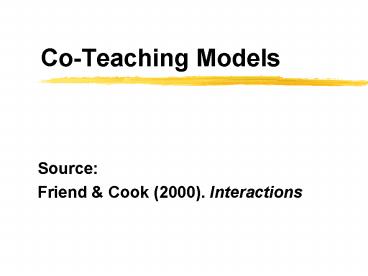CoTeaching Models - PowerPoint PPT Presentation
1 / 12
Title:
CoTeaching Models
Description:
Jointly delivering instruction (General education provides the instructional ... Should not be used for initial instruction. Alternative Teaching ... – PowerPoint PPT presentation
Number of Views:84
Avg rating:3.0/5.0
Title: CoTeaching Models
1
Co-Teaching Models
- Source
- Friend Cook (2000). Interactions
2
Objectives
- Define co-teaching
- Describe the rationale for using co-teaching
- Identify six approaches to co-teaching and
provide examples of each
3
Co-teaching Rationale
- Meets the individual needs of students
- Goal is to provide individualized instruction
(less fragmented and more contextualized) in a
general education environment - Reduce stigma attached by pull-out programs
- Provide opportunities for flexible scheduling
- Creates positive social interactions
- Co-teachers have a sense of collegial support
4
Characteristics of Co-teaching
- Two or more professionals (Peers with shared
teaching responsibility) - Jointly delivering instruction (General education
provides the instructional framework, yet the
curriculum may be modified for students with
disabilities or others who need accommodations) - Diverse group of students (Allows for teachers to
respond to the diverse range of needs of their
students, lowers student/teacher ratio and
expands professional expertise) - Shared classroom space (Co-teachers teach in a
single classroom)
5
Co-teaching Approaches
- One TeachingOne Observing
- One TeachingOne Drifting
- Station Teaching
- Parallel Teaching
- Alternative Teaching
- Team Teaching
6
One Teaching/One Observing
- Requires little joint planning time
- Provides opportunity for ESE teachers to learn
about General Education Curriculum - Particularly effective for teachers new to
collaboration - -Can result in special educator as being
relegated to role of an assistant
7
One Teaching/One Drifting
- Requires little joint planning time
- Provides opportunity for ESE teachers to learn
about General Education Curriculum - Particularly effective for teachers new to
collaboration - -Can result in special educator as being
relegated to role of an assistant - -The second teacher can sometimes be a
distraction - -Students can become dependent on the drifter
8
Station Teaching
- Each professional has separate responsibility
for delivering instruction - Lower teacherstudent ratio
- Students with disabilities can be more easily
integrated into small groups - -Noise level can be distracting
- -Movement can be distracting
9
Parallel Teaching
- Lower teacherstudent ratio
- Heterogeneous grouping
- Allows for more creativity in lesson delivery
- -Teachers must both be comfortable in content and
confident in teaching the content - -Should not be used for initial instruction
10
Alternative Teaching
- Helps with attention problem students
- Allows for re-teaching, tutoring, or enrichment
- -Can be stigmatizing to group who is
alternatively taught - -ESE teacher can be viewed as an assistant if
he/she is always in alternative teaching role
11
Team Teaching
- Greatest amount of shared responsibility
- Allows for creativity in lesson delivery
- Prompts teachers to try innovative techniques
neither professional would have tried alone - -Requires greatest amount of trust and commitment
- -Most difficult to implement
12
School-wide Factors that Influence Co-teaching
- Administrative Support
- ESE Caseload
- Voluntary vs. Involuntary Participation
- Scheduling (For teaching and planning)
- Problem-solving techniques































